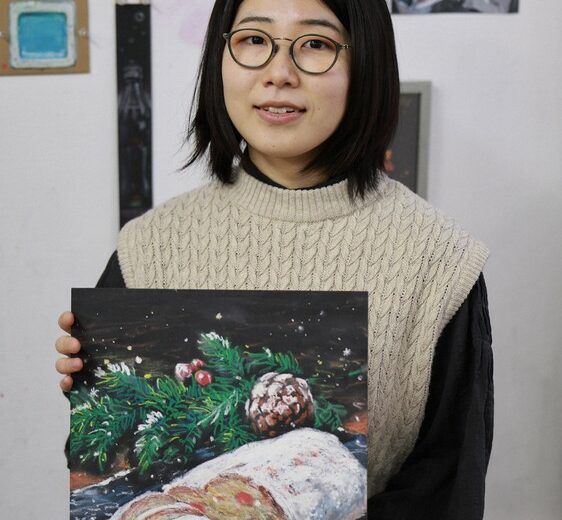ASAHI, Chiba — Chalkboard art transforms school blackboards into vibrant artistic spaces. This art form has been gaining popularity in Japan, with many students showcasing their talents in the “Kokuban Art Koshien” (blackboard art national championships), which began in 2015. The Mainichi Shimbun spoke with Rana Suzuki, a 30-year-old blackboard artist living in Asahi, Chiba Prefecture, who has been active since she was a student over a decade ago and is sharing her work on social media, about her methods and the appeal of this art form.
Mainichi Shimbun
What motivated you to begin your chalkboard art?
Rana Suzuki
: I drew a large fried egg using chalk, calling it “blackboard hijacking,” during a university extracurricular activity to introduce elementary school children to art. It was well received, which led me to pursue chalkboard art. The appeal lies in the ease of creating large drawings.
MS
: Do you use regular chalk?
RS
: There are chalks specifically for blackboard art, but I use the same chalk as school teachers. I use seven colors, including white, red, blue and yellow.
MS
: How long does it take to create a piece?
RS
: It varies, but it typically takes about six hours from start to finish. For “surprise” pieces, I draw during after-school hours or other times. Recently, I’ve also done live drawings (in front of children), allowing them to enjoy the process and join in erasing the work at the end.
MS
: How many pieces have you created so far?
RS
: I’ve done more than 200 pieces, traveling to various places from (the northernmost prefecture of) Hokkaido to Fukuoka Prefecture (in the southwest). Most requests come from elementary schools, and recently I’ve been invited to corporate events as well. The subject matter is decided through talks, but sometimes I make suggestions based on the school’s atmosphere.
MS
: How do the children react?
RS
: They’re amazed as they come into the classroom, often exclaiming, ‘Wow,” and, “Who drew this?” I hope they first see the impact from a distance, then appreciate the detailed expressions up close. I sometimes depict school events like sports day. If these pieces help them reflect on their memories, I feel my work was worthwhile.
MS
: You must hesitate to erase your work.
RS
Children remark, “It’s pointless to erase it,” and suggest, “We should preserve the artwork and utilize another blackboard for our lessons.” While their attachment pleases me, this transient nature allows me to create on such an extensive scale. Were it intended to last a century, I would avoid using chalk altogether.
MS
Would you be interested in exploring other ventures aside from chalkboard art?
RS
In 2018, I created a roughly 100-meter-long “Ryuo Emaki” (dragon king scroll painting) on a seawall in Asahi’s Iioka district, which was impacted by the 2011 Great East Japan Earthquake tsunami. Local children contributed to this project by adding their handprints. This experience made a significant impact on me, and I am eager to engage in more extensive community-driven initiatives in the future.
Profile
Born in Asahi, Chiba Prefecture, in 1994, Rana Suzuki started practicing blackboard art during her time at Musashino Art University. She emerged victorious in the national “Art Battle Japan” contest in 2019, which showcases emerging talent across the country. Additionally, her acrylic artwork made it through the selection process for the esteemed Nika Art Exhibition in 2021.
(Original Japanese by Takashi Kondo, Choshi Local Bureau)
